| Article ID | Journal | Published Year | Pages | File Type |
|---|---|---|---|---|
| 3046149 | Clinical Neurophysiology | 2009 | 9 Pages |
ObjectiveThis article proposes a method to automatically identify and label event-related potential (ERP) components with high accuracy and precision.MethodsWe present a framework, referred to as peak-picking Dynamic Time Warping (ppDTW), where a priori knowledge about the ERPs under investigation is used to define a reference signal. We developed a combination of peak-picking and Dynamic Time Warping (DTW) that makes the temporal intervals for peak-picking adaptive on the basis of the morphology of the data. We tested the procedure on experimental data recorded from a control group and from children diagnosed with developmental dyslexia.ResultsWe compared our results with the traditional peak-picking. We demonstrated that our method achieves better performance than peak-picking, with an overall precision, recall and F-score of 93%, 86% and 89%, respectively, versus 93%, 80% and 85% achieved by peak-picking.ConclusionWe showed that our hybrid method outperforms peak-picking, when dealing with data involving several peaks of interest.SignificanceThe proposed method can reliably identify and label ERP components in challenging event-related recordings, thus assisting the clinician in an objective assessment of amplitudes and latencies of peaks of clinical interest.
